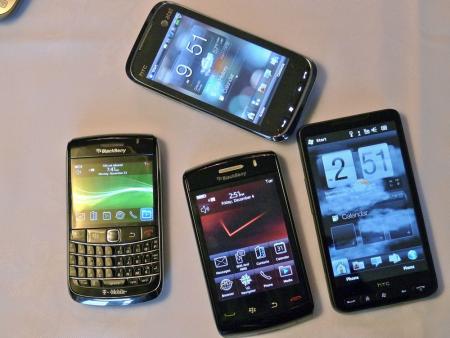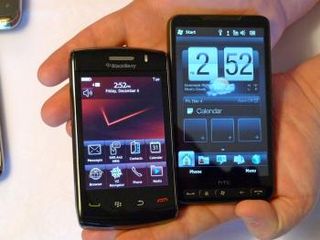BlackBerry review from a Windows Mobile perspective - Smartphone Round Robin

An e-mail powerhouse with an aging operating system whose shelf life may or may not be slowly ticking down. Slightly iterative hardware every six months or so. Adored by business users. Sounds familiar, doesn't it?
But, no, we're not talking about Windows Mobile. It's BlackBerry week in the third annual Smartphone Round Robin, and CrackBerry Kevin brought us two of his platform's best -- the Bold 9700 (CrackBerry review) and the Storm 2 (CrackBerry review). The former, a front-facing QWERTY device with a new navigation feature. The latter, a follow-up to Research in Motion's much-maligned first touchscreen device, and the first without a physical keyboard.
So join us as we jump into the world of the CrackBerry. A suit-and-tie device for people who are more than suit-and-tie people. Who knows ... we might even surprise ourselves.
And remember, we have a forum thread running at CrackBerry.com, and a post could be worth a free smartphone of your choice (up to $1,000).
Before we dive into it, it's revisit our sit-down with Kevin Michaluk, shall we?
The hardware
Storm 2
Oh, no. Not the Storm 2. Seriously? With as bad as the Storm 1 was received, we're giving it another shot? OK.
Get the Windows Central Newsletter
All the latest news, reviews, and guides for Windows and Xbox diehards.
And, truth be told, I was pleasantly surprised with the sequel. For the unaware, the Storm line is RIM's first foray into the touchscreen market, and it was an obvious reaction to the introduction of the iPhone. As if somebody in Waterloo said, "We will have one of those, too!" and rushed it out the door. And with the Storm came the introduction of SurePress. Yeah, it's a touchscreen, but it's a touchscreen build on top of a giant button. Touch the icon on the screen to select it, and then physically press the screen into the phone to activate.

That in itself isn't a horrible technology -- though you likely either love it or hate it. Problem was responsiveness. The screen was resting on top of one button, in the middle of the device. And so when you got to the edges, well, things weren't so responsive.
But that's changed with the Storm 2. The new 3.3-inch SurePress screen (at an odd 360x480 resolution) now rests on four buttons, one in each corner of the device, and they're electrical, not mechanical. That means no moving parts to break down, and it also presents a very cool way to lock the screen. When the screen is dark (aka turned off), the SurePress mechanism is also turned off, and thus you can't inadvertently click on anything. It physically will not click. Very cool.
OK, so that's the elephant the room when it comes to the Storm 2. The other important specs of the Storm 2: Qualcomm MSM7600 processor, 2GB storage memory, 3MP camera, 256MB RAM, WiFi b/g and ll the usual bells and whistles.
Buttons and icons on the screen are big and easy to hit. I'm not crazy about the default look, kind of a neon ghosty sort of thing. But that's easily fixed with one of the 3 million themes available for BlackBerries.
With the larger screen of the Storm 2 comes the ability for real multimedia playback, and it does so with ease. Video was smooth crisp.
All in all, if you're looking for a nontraditional BlackBerry that can truly do more than just messaging, the Storm 2 is a pretty good bet and a much better contestant than its predecessor.
BlackBerry Bold 9700
As you saw in our hands-on video, we got a bit nostalgic with the Bold 9700. Front-facing QWERTY phones were our Windows Mobile bread and butter for a long, long time, even though we're more and more giving ourselves over to the world of touchscreen phones and on-screen keyboards.

The Bold 9700 is the quintessential BlackBerry messaging device. It's what you think of when you think "BlackBerry." The keyboard -- solid as a rock. They keys have excellent spacing and travel, typical for a BlackBerry phone and better than just about anybody else out there.
And the screen has an incredible resolution for its size -- 480x360 pixels, crammed into a space just 2.4 inches in diagonal. That. Is. Sick.
But none of that's really new with the bold line. For the most part, the Bold 9700 is much like its predecessor (and first in the series), the Bold 9000. But the newer model is noticeably more narrow (a full 6 millimeters), and gone is the trackball. For as cool as the trackball is (or was), it's a moving part. And moving parts break. So, gone is the trackball, replaced by an optical trackpad. About the size of a small fingernail, it senses the motion of a thumb (or finger -- do BlackBerry users still have those?) across it, and then moves through the icons on the screen. And once you get used to the sensitivity of the thing -- it's fast! -- it's a darn efficient way to move around an operating system. It's still not the same as a mechanical D-pad, but let's hope we see it on more devices in the future.
BIS, BES, BBM and Exchange
We like to poke fun at BlackBerry anytime (and every time) the BlackBerry Internet Service (BIS) goes down, cutting off the crack to millions of users. OK, it's not a daily occurrence or anything, it's just that so many people going through withdrawal at the same time tend to make a lot of noise.
And so we like to point out that routing an entire platform's blood through a single heart (the BIS) presents a single point of failure that's outside users' control. And that's the case for most "normal" (read: non-corporate) smartphone users. Shut down the BIS for an hour or two (or six ... or 10) and BlackBerry users are forced to (GASP!) go outside or something. OK, that's a bit of an exaggeration, but not grossly so.

But while we poke fun at the single point of failure, it's really not that different than on any other platform, is it? If your POP mail goes down, it goes down. If your business' Microsoft Exchange server is on the fritz, well, no e-mail for you either. (The BES, by the way, essentially is RIM's version of Exchange). The long and short of it is this: Don't expect the single point of failure argument to drive people from their BlackBerry.
We have, however, seen a bit of a corporate shift away from the BES and to Exchange and Microsoft System Center Mobile Device Manager. Chances are your business is running Windows (on a volume licensing package). And so once you're supporting that, you might as well run Exchange more cheaply. And that's where Windows Mobile (current and future) should continue to have a leg up.
Then there's BlackBerry Messenger. See, there's a little club all those BlackBerry users belong to, and the price of admission is your soul acceptance of the BlackBerry Messenger. At its core, it's really no more than IM/SMS exclusively for BlackBerry users. But it's fast. It's easy. And it's addictive.
One of the questions I asked in the CrackBerry.com forums was "Would you like to see BlackBerry Messenger opened up to over smartphone platforms?" Overwhelmingly, the answer was "No." It's an exclusive club, and they like it that way. Open BBM (as it's called on the streets) to the rest of us, and it looses what makes it special -- you have to have a BlackBerry to use it. I'm pretty sure they're having jackets made.
What makes it a CrackBerry
Chances are f you're reading this, you're probably an information whore, too. It's the same on Windows Mobile as it is BlackBerry or the iPhone or Nokia or Android or whatever. We want our e-mail, we want our messages, and we want them now. These days, however, it's not just RIM doing the push thing. Obviously Microsoft Exchange opened things up to a very wide audience. And with Android, gmail users are in hog heaven. But RIM was the first. E-mails received almost instantly. BlackBerry Messenger keeping the one-liners going long before Twitter.
Oh, and one more addiction: That pulsating red light on each phone that signifies you have a message. There's no sense in having a BlackBerry if you get few e-mails, so it's safe to assume that there's something always coming in. While notification signals are nothing new on smartphones, there's just something about the little red blinker on a BlackBerry that's like a porch light for a firefly. You can't help but be drawn to it. Another question asked on the forums: "How long can you ignore the light before you lose it?" The best answers, from three addicts and one very brave soul:
It has never gotten to 2 blinks. Ever. - BoardRider53Forever. I have 800 unread messages on my phone and I'm not flinching. - MashkaPut it this way: I can "sense" when my light is blinking without even looking at it. Kind of like how they say mothers have ESP with their children and can sense their thoughts, the same applies with me and my blackberry haha. Scary stuff. - Kneeland24It depends. If I'm having sex or watching baseball it's pretty easy to ignore. - OCD SS
That about sums that up.
Phil is the father of two beautiful girls and is the Dad behind Modern Dad. Before that he spent seven years at the helm of Android Central. Before that he spent a decade in a newsroom of a two-time Pulitzer Prize-finalist newspaper. Before that — well, we don't talk much about those days. Subscribe to the Modern Dad newsletter!
